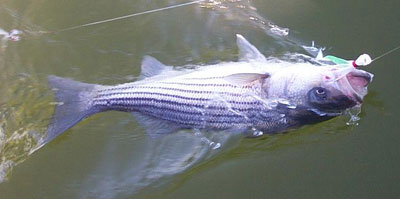 In the Chesapeake Bay, trophy striped bass, known locally as “rockfish”, are a sought after species. Anglers fish using a variety of methods including trolling, chumming, fishing with live bait, cut bait, and casting artificial lures.
In the Chesapeake Bay, trophy striped bass, known locally as “rockfish”, are a sought after species. Anglers fish using a variety of methods including trolling, chumming, fishing with live bait, cut bait, and casting artificial lures.
Much of the spring fishing is done in the shipping channels of the Chesapeake Bay. Typically, anglers troll at speeds of 2-4 knots using large bucktails, large spoons, umbrella rigs, and plugs.
Fall and winter trolling for big rockfish is very similar to the techniques described for school rockfish. The weather for the fall season is typically very heavy and cold, making a large boat almost mandatory.
One important difference worth noting is the tendency of big fish to sometimes be indicated by the presence of gannets. Gannets look and act very differently than gulls and are seldom seen on the bay until November. Gannets feed almost exclusively on large baitfish such as menhaden.
This trait is shared with the large rockfish and both predators are normally present together. Seeing gannets and rockfish working a school of bait together is one of the most dramatic and exciting events in nature.
A variety of high tech rigs as well as traditional lures are available for catching trophy rockfish. One of the oldest rigs is the “bottom bouncer” rig, often run on wire line. The rig consists of one or two bucktails with 9 inch shad bodies, rigged 20′ or so behind a 20-32 oz. sinker.
Another rig which is good on wire is a pair of 8 oz. bucktails with 9 inch shad bodies. This tandem rig does not require a dropper sinker. For more on wire line see articles on lure depth and trolling with wire line.
Another productive rig is a spoon-jig combination. A 3 way swivel has an 8oz. bucktail dropped down 18-24″ and a spoon trailing behind 20-30′. The spoon should be rigged on #80 or #125 line with a ball bearing swivel at mid-point between the 3 way and the spoon. This rig works well in both the spring and fall fisheries.
Two other rigs deserve mentioning although both are somewhat temperamental. The first is the umbrella rig. The outer arms of the umbrella receive shad bodies which are attached with a swivel. A large bucktail or parachute lure is rigged on the center line of the umbrella back behind the rig. The jig is the only part armed with a hook. The umbrella is difficult to launch and is best run very far back in the spread, even to 300′.
Umbrella rigs and variations are discussed on this site. For an alternative to umbrella rigs, see rigging a shad daisy chain for rockfish.
The most dreadful of all rockfish lures is the Mann’s Stretch 30. This lure dives deep and can be run by itself or preceded with a heavy dropper. The lure tends to run in a circular “hunting” path. If the spacing and depth of the other lures is not correct, the Stretch will seek out every line in the water, wrap around each rig several times and then proceed to jump out of the water. The remedy for this is several crewmembers with line cutters.
In spite of it’s problems, the Stretch 30 and it’s little brother the Stretch 25 catch fish. Anglers often carry a red/white model and a “grey ghost”.